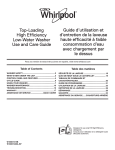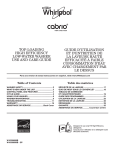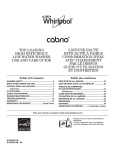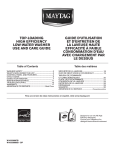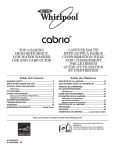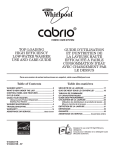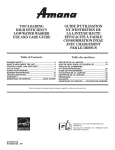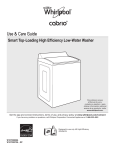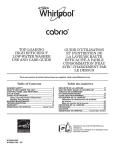Download 6AWTW5550XW
Transcript
TOP-LOADING HIGH EFFICIENCY LOW-WATER WASHER USE AND CARE GUIDE Table of Contents WASHER SAFETY...................................................... 2 WASHER DISPOSAL................................................. 3 WHAT’S NEW UNDER THE LID?.............................. 4 CONTROL PANEL AND FEATURES......................... 5 CYCLE GUIDE............................................................ 6 USING YOUR WASHER............................................. 7 Using Laundry Product Dispensers............................. 8 Starting Your Washer..................................................... 8 WASHER MAINTENANCE............................................ 10 TROUBLESHOOTING.................................................... 12 ASSISTANCE OR SERVICE......................................... 16 Designed to use only HE High Efficiency detergents. W10045637A MODEL 6AWTW5550XW WASHER SAFETY IMPORTANT SAFETY INSTRUCTIONS WARNING: To reduce the risk of fire, electric shock, or injury to persons when using the washer, follow basic precautions, including the following: Read all instructions before using the washer. Do not wash articles that have been previously cleaned in, washed in, soaked in, or spotted with petrol, dry-cleaning solvents, other flammable or explosive substances as they give off vapours that could ignite or explode. Do not add petrol, dry-cleaning solvents, or other flammable, or explosive substance to the wash water These substances give off vapours that could ignite or explode. Under certain conditions, hydrogen gas may be produced in a hot water system that has not been used for 2 weeks or more. HYDROGEN GAS IS EXPLOSIVE. If the hot water system has not been used for such a period, before using the washing machine, turn on all hot water taps and let the water flow from each for several minutes. This will release any accumulated hydrogen gas. As the gas is flammable, do not smoke or use open flame during this time. Do not allow children to play on or in the washer. Close supervision of children is necessary when the washer is used near children. This appliance is not intended for use by persons (including children) with reduced physical, sensory or mental capabilities, or lack of experience and knowledge, unless they have been given supervision or instructions concerning use of the appliance by persons responsible for their safety. Before the washer is removed from service or discarded, remove the door or lid. Do not reach into the washer if the drum, tub or agitator is moving. Do not install or store the washer where it will be exposed to the weather. Do not tamper with controls. Do not repair or replace any part of the washer or attempt any servicing unless specicically recommended in this Use and Care Guide/Installation Instruction. See Installation Instructions for earthing requirements. If the supply cord is damaged, it must be replaced by the manufacturer or its service agent or a similarly qualified person in order to avoid a hazard. SAVE THESE INSTRUCTIONS WASHER DISPOSAL 2 WASHER DISPOSAL 3 WHAT’S NEW UNDER THE LID? Cleaning with Less Water Washplate Traditional agitator-style washer Washer with low-water washplate wash system The most striking difference in your new washer is the low-water washplate wash system. The washer automatically adjusts the water level to the load size—no water level selector is needed. As the washer dampens and moves the load, the level of the clothes will settle in the basket. This is normal, and does not indicate that more clothes should be added. IMPORTANT: You will not see a washer basket full of water as with your past agitator-style washer. Choosing the Right Detergent Use only High Efficiency detergents. The package will be marked “HE” or “High Efficiency.” Low-water washing creates excessive sudsing with a regular non-HE detergent. Using regular detergent will likely result in longer cycle times and reduced rinsing performance. It may also result in component failures and noticeable mold or mildew. HE detergents are made to produce the right amount of suds for the best performance. Follow the manufacturer’s instructions to determine the amount of detergent to use. When loading the washer with dirty laundry, fill it evenly around the basket wall. Automatic Load Size Sensing Once you start the cycle, the lid will lock, and the washer will begin the sensing process to determine the correct water level for the load. This may take several minutes. You will find a step-by-step description in the “Cycle Status Lights” section. Use only High Efficiency (HE) detergent. Concentrated Cleaning Low-water cleaning means concentrated cleaning. Rather than diluting detergent as done in an agitator-style washer, this washer delivers the detergent directly to the soils. Normal Sounds You Can Expect At different stages of the wash cycle, you may hear sounds and noises that are different from those of your previous washer. For example, you may hear a clicking and hum at the beginning of the cycle, as the lid lock goes through a self-test. There will be different kinds of humming and whirring sounds as the washplate moves the load. And sometimes, you may hear nothing at all, as the washer determines the correct water level for your load or allows time for clothes to soak. The washplate moves the load while water is added in small amounts until the load is wet. This low-water wash method uses less water and energy compared to a traditional agitator-style washer. 4 CONTROL PANEL AND FEATURES 1 2 4 1 WASH CYCLE KNOB 2 CYCLE OPTIONS Use the Wash Cycle knob to select available cycles on your washer. Turn the knob to select a cycle for your laundry load. See “Cycle Guide” for detailed descriptions of cycles. When you select a cycle, its default settings will light up. Not all cycles and options are available on all models. TEMP Temperature Control senses and maintains uniform water temperatures by regulating incoming hot and cold water. Select a wash temperature based on the type of fabric and soils being washed. For best results and following the garment label instructions, use the warmest wash water safe for your fabric. • Warm and hot water may be cooler than what your previous washer provided. • Even in a Cool water wash, some warm water may be added to the washer to maintain a minimum temperature. SOIL LEVEL Soil level (wash time) is preset for each wash cycle. For most loads, use the soil level that is preset with the cycle you have chosen. For heavily soiled and sturdy fabrics, press Soil Level to select more wash time, if needed. For lightly soiled and delicate fabrics, press Soil Level to select less wash time, if needed. Lighter soil level setting will help reduce tangling and wrinkling. SPIN SPEED This washer automatically selects the spin speed based on the cycle selected. The preset speeds can be changed. Not all spin speeds are available with all cycles. • Faster spin speeds mean shorter dry times, but may increase wrinkling in your load. • Slower spin speeds mean less wrinkling, but will leave your load more damp. You may also add or remove options for each cycle. Not all options can be used with all cycles, and some are preset to work with certain cycles. 3 EXTRA RINSE This option can be used to automatically add a second rinse to most cycles. 4 FABRIC SOFTENER This option must be selected if using fabric softener during a cycle. It ensures that fabric softener is added at the correct time in the rinse for even distribution. 5 3 5 CYCLE STATUS LIGHTS INDICATOR The Cycle Status Lights show the progress of a cycle. At each stage of the process, you may notice sounds or pauses that are different from traditional washers. SENSING When the START/Pause/Unlock button is pressed, the washer will first perform a self-test on the lid lock mechanism. You will hear a click, the basket will make a slight turn, then lid will unlock briefly before locking again. Once the lid has locked the second time, the washer will slowly spin the dry load to estimate the load size and amount of water needed, and begin adding water. The washer will then move the load briefly, pause to allow water to soak into the load, and resume adding water. This process may repeat until the correct amount of water has been added for the load. You may also hear water flowing through the dispenser, adding detergent to the load. NOTE: The sensing light may also come on during the Wash portion of the cycle. This is normal. WASH You will hear the washplate moving the load. Unlike traditional washers, the load is not covered with water. Low-water cleaning means concentrated cleaning. Rather than diluting detergent as done in an agitator-style washer, this washer delivers the detergent directly to the soils. The motor sounds may change at different stages in the cycle. The wash time is determined by the selected soil level. RINSE You will hear sounds similar to the wash cycle as the washer rinses and moves the load. Fabric softener will be added if the Fabric Softener option was selected. Some cycles use spray rinsing. SPIN The washer spins the load at increasing speeds for proper water removal, based on selected cycle and spin speed. DONE Once the cycle is complete, this light will come on. Remove the load promptly for best results. 5 LID LOCK To allow for proper load sensing, the lid will lock and the Lid Lock light will turn on. This light indicates that the lid is locked and cannot be opened. CYCLE GUIDE If you need to open the lid, press START/Pause/Unlock. The lid will unlock once the washer movement has stopped. This may take several minutes if the load was spinning at high speed. Press START/Pause/Unlock again to resume the cycle. Settings and options shown in bold are default settings for that cycle. For best fabric care, choose the cycle that best fits the load being washed. Not all cycles and options are available on all models. Maximum Load: 8.0 kg Items to wash: Cycle: Wash/Rinse Temperature: Machine-wash silks, handwash fabrics Delicate Hot/Cold Warm/Cold Cool/Cold Cold/Cold Small loads, cottons, polyester, perm press Cottons, linens, sheets, and mixed garment loads Quick Wash Hot/Cold Warm/Cold Cool/Cold Cold/Cold Hot/Cold Warm/Cold Cool/Cold Cold/Cold Normal* Spin Speed: Available Options: Cycle Details: High Extra Heavy Low Heavy No Spin Medium Light Extra Rinse Use this cycle to wash lightly soiled garments indicating “Machine Washable Silks” or “Gentle” cycle on the care label. Place small items in mesh garment bags before washing. Extra Heavy High Heavy Low Medium No Spin Light High Extra Heavy No Spin Heavy Medium Light Extra Rinse Use this cycle to wash small, lightly soiled loads of 2–3 items that are needed in a hurry. This cycle features a spray rinse. Use Hot or Warm wash temperature for normally soiled cottons and mixed fabric loads. Cool and Cold wash settings allow you to wash smaller, slightly soiled loads. This cycle features a spray rinse. Low-speed spin is not available. The Eco Normal cycle allows you to wash smaller loads (7.0 kg or smaller) to increase energy savings compared to the Normal cycle. When this cycle is used, the wash cycle will use cooler wash water temperatures than the Normal cycle. Cottons, sheets, and mixed garment loads. Eco Normal Hot/Cold Warm/Cold Cool/Cold Cold/Cold High No-iron fabrics, cottons, perm press, linens, synthetics Large items such as sleeping bags, small comforters, jackets Sturdy fabrics, colorfast items, towels, jeans Casual Hot/Cold Warm/Cold Cool/Cold Cold/Cold Hot/Cold Warm/Cold Cool/Cold Cold/Cold High Low No Spin Heavy Duty Swimsuits and items requiring rinsing without detergent Rinse & Spin Hand-washed items or dripping wet items Drain & Spin Heavily soiled fabrics No clothes in washer Bulky Items Soak Clean Washer Soil Level: Extra Rinse Extra Heavy Heavy Medium Light Extra Rinse Extra Heavy Heavy Medium Light High Extra Heavy Low Heavy No Spin Medium Light Extra Rinse Hot/Cold Warm/Cold Cool/Cold Cold/Cold High Extra Heavy No Spin Heavy Medium Light Extra Rinse Cold/Cold High Low No Spin High Low No Spin Hot/Cold Warm/Cold Cool/Cold Cold/Cold Hot/Cold No Spin Extra Heavy Heavy Medium Light High Extra Heavy Extra Rinse Use this cycle to wash loads of no-iron fabrics such as sport shirts, blouses, casual business clothes, permanent press, and blends. Use this cycle to wash large items such as jackets and small comforters. The washer will fill with enough water to wet down the load before the wash portion of the cycle begins. Do not overload basket. Use this cycle for heavily soiled or sturdy items. Water-level sensing process may take longer for some items than for others because they will absorb more water than other fabric types. Combines a rinse and spin for loads requiring an additional rinse cycle or to complete a load after power interruption. Spin speed is selectable; default is high. This cycle uses a higher, preset water level. Also use for loads that require rinsing only. This cycle uses a spin to shorten drying times for heavy fabrics or special-care items washed by hand. Use this cycle to drain washer after cancelling a cycle or completing a cycle after a power failure. Select Soil Level to adjust soaking cycle time. After time has expired, water will drain but washer will not spin. Use once a month to keep the inside of the washer fresh and clean. Higher water levels and bleach work together to thoroughly clean the washer interior. eference programme for Energy and Water Labeling, according to Australian Standards AS/NZS 2040.1 and AS/NZS 2040.2, R with the following options selected: Normal, Warm Temperature, Extra Heavy Soil Level, and High Spin Speed. * 6 USING YOUR WASHER 1. Sort and prepare your laundry • Empty pockets. Loose change, buttons, or any small object can pass under the washplate and become trapped, causing unexpected sounds. • Sort items by recommended cycle, water temperature, and colorfastness. • Separate heavily soiled items from lightly soiled. • Separate delicate items from sturdy fabrics. • Do not dry garments if stains remain after washing, because heat can set stains into fabric. • Treat stains promptly. • Close zippers, fasten hooks, tie strings and sashes, and remove non-washable trim and ornaments. • Mend rips and tears to prevent further damage to items during washing. 2. Load laundry into washer Load garments in loose heaps evenly around basket wall. Do not wrap large items such as sheets around the washplate; load them in loose piles around the sides of the basket. Try mixing different sized items to reduce tangling. IMPORTANT: Items need to move freely for best cleaning and to reduce wrinkling and tangling. Helpful Tips: • When washing water-proof or water-resistant items, load evenly. See “Cycle Guide” for tips and more information on using the Bulky Items cycle. • Use mesh garment bags to help avoid tangling when washing delicate or small items. • Turn knits inside out to avoid pilling. Separate lint-takers from lint-givers. Synthetics, knits, and corduroy fabrics will pick up lint from towels, rugs, and chenille fabrics. NOTE: Always read and follow fabric care label instructions to avoid damage to your garments. 7 Using Laundry Product Dispensers 3. Add HE detergent to dispenser Detergent tray Add a measured amount of HE detergent or dissolve detergent in warm water and pour into detergent tray. This tray holds 89 mL (3 oz.). Do not overfill tray – adding too much detergent may cause detergent to be dispensed into the washer too early. IMPORTANT: Use only High Efficiency detergents. The package will be marked “HE” or “High Efficiency.” Low-water washing creates excessive sudsing with a regular non-HE detergent. Using regular detergent will likely result in longer cycle times and reduced rinsing performance. It may also result in component failures and noticeable mold or mildew. HE detergents are made to produce the right amount of suds for the best performance. Follow the manufacturer’s instructions to determine the amount of detergent to use. Using Oxi or color-safe bleach: If using an Oxi or color-safe bleach laundry boost product, add to the bottom of the washer basket before adding clothes. HELPFUL TIP: See “Washer Maintenance” for information on recommended method of cleaning washer dispenser trays. 5. Add fabric softener to dispenser Fabric softener tray Pour a measured amount of liquid fabric softener into tray. Always follow manufacturer’s directions for correct amount of fabric softener based on your load size. Close dispenser drawer, then select Fabric Softener option. IMPORTANT: Fabric Softener option must be selected to ensure proper distribution at correct time in cycle. Do not overfill or dilute. Overfilling dispenser will cause fabric softener to immediately dispense into washer. If Extra Rinse option is selected, fabric softener will be dispensed into the last rinse. It is normal for a small amount of water to remain in the dispenser at the end of a cycle. Starting Your Washer 6. Press POWER to turn on washer 4. Add liquid chlorine bleach to dispenser Make sure the dispenser drawer is closed completely, then press POWER to turn on the washer. Liquid Chlorine Bleach 7. Select cycle Do not overfill, dilute, or use more than 250 mL (1 cup). Do not use color-safe bleach or Oxi products in the same cycle with liquid chlorine bleach. 8 Turn cycle knob to choose your wash cycle. For more information, see “Control Panel and Features.” 8. Select cycle settings 10. Press START/Pause/Unlock to begin wash cycle Once you select a cycle, the default settings for that cycle will be lit. Press the cycle settings buttons to change the Temperature, Soil Level, and Spin Speed, if desired. NOTE: Always read and follow fabric care label instructions to avoid damage to your garments. Wash Temp Hot Some cold water is added to save energy. This will be cooler than your hot water heater setting. Warm Some cold water will be added, so this will be cooler than what your previous washer provided. Suggested Fabrics Whites and pastels Durable garments Heavy soils Bright colors Moderate to light soils Cool – brights/darks Warm water is added to assist in soil removal and to help dissolve detergents. Colors that bleed or fade Cold Warm water may be added to assist in soil removal and to help dissolve detergents. Dark colors that bleed or fade Press the START/Pause/Unlock button to start the wash cycle. When the cycle has finished, the DONE indicator will light. Promptly remove garments after cycle has completed to prevent odor, reduce wrinkling, and rusting of metal hooks, zippers, and snaps. Unlocking the lid to add garments: If you need to open the lid to add 1 or 2 missed garments, you may do so during the first portion of the Sensing step. Press START/Pause/Unlock; the lid will unlock once the washer movement has stopped. This may take several minutes if the load was spinning at high speed. Then close the lid and press START/Pause/Unlock again to restart the cycle. If lid is left open for more than 10 minutes, water will pump out. Light soils Light soils 9. Select cycle options Select any other cycle options you may wish to add, if not previously set. Some cycles will automatically add certain options such as Extra Rinse. These can be turned off, if desired. NOTE: Not all options are available with all cycles. 9 WASHER MAINTENANCE WATER INLET HOSES Replace inlet hoses after 5 years of use to reduce the risk of hose failure. Periodically inspect and replace inlet hoses if bulges, kinks, cuts, wear, or leaks are found. When replacing your inlet hoses, mark the date of replacement on the label with a permanent marker. CLEANING YOUR WASHER Keep your washer as clean and fresh as your clothes. To keep washer interior odor-free, follow this recommended monthly cleaning procedure: CLEANING YOUR DISPENSER TRAY You may find laundry product residue in your dispenser trays. To remove residue, follow this recommended cleaning procedure: 1. Pull tray out until you feel resistance. 2. Lift up slightly, and then continue pulling out. 3. Wash in warm, soapy water, using a mild detergent. 4. Rinse with warm water. 5. Air dry, or dry with a towel, then place back into slot. 1. Make sure the washer is empty. 2. If using liquid chlorine bleach, add 1 cup (250 mL) to liquid chlorine bleach dispenser. IMPORTANT: Dispenser trays are not dishwasher safe. IMPORTANT: Do not add detergent to CLEAN WASHER cycle. Do not use more than recommended amount of bleach to avoid damaging product over time. 3. Close washer lid. 4. Press POWER. 5. Select CLEAN WASHER cycle. 6. Press START/Pause/Unlock. Water will pour into washer for a moment and pause, lid will lock, then cycle will continue. NOTE: For best results, do not interrupt cycle. If cycle must be interrupted, press POWER and run a RINSE AND SPIN cycle to ensure cleaner or bleach have been rinsed from washer. To clean exterior: 1. Use a soft, damp cloth or sponge to wipe up any spills. 2. Use all-purpose surface cleaner, if needed. IMPORTANT: To avoid damaging the washer’s finish, do not use abrasive products. 10 NON-USE AND VACATION CARE Operate your washer only when you are home. If moving, or not using your washer for a period of time, follow these steps: 1. Unplug or disconnect power to washer. 2. Turn off water supply to washer, to avoid flooding due to water pressure surge. WINTER STORAGE CARE IMPORTANT: To avoid damage, install and store washer where it will not freeze. Because some water may stay in hoses, freezing can damage washer. If storing or moving during freezing weather, winterize your washer. To winterize washer: 1. Shut off both water taps, disconnect and drain water inlet hoses. 2. Put 1 qt. (1 L) of R.V.-type antifreeze in basket and run washer on RINSE AND SPIN cycle for about 30 seconds to mix antifreeze and remaining water. 3. Unplug washer or disconnect power. TRANSPORTING YOUR WASHER 1. Shut off both water taps. Disconnect and drain water inlet hoses. 2. If washer will be moved during freezing weather, follow “Winter Storage Care” directions before moving. 3. Disconnect drain from drain system and drain any remaining water into a pan or bucket. Disconnect drain hose from back of washer. 4. Unplug power cord. 5. Place inlet hoses and drain hose inside washer basket. 6. Drape power cord over edge and into washer basket. 7. Place packing tray from original shipping materials back inside washer. If you do not have packing tray, place heavy blankets or towels into basket opening. Close lid and place tape over lid and down front of washer. Keep lid taped until washer is placed in new location. REINSTALLING/USING WASHER AGAIN To reinstall washer after non-use, vacation, winter storage, or moving: 1. Refer to “Installation Instructions” to locate, level, and connect washer. 2. Before using again, run washer through the following recommended procedure: To use washer again: 1. Flush water pipes and hoses. Reconnect water inlet hoses. Turn on both water taps. 2. Plug in washer or reconnect power. 3. Run washer through BULKY ITEMS cycle to clean washer and remove antifreeze, if used. Use only HE High Efficiency detergent. Use half the manufacturer’s recommended amount for a medium-size load. 11 TROUBLESHOOTING First try the solutions suggested here for assistance and to possibly avoid a service call. If you experience Possible Causes Solution Feet may not be in contact with the floor and locked. Front and rear feet must be in firm contact with floor, and washer must be level to operate properly. Jam nuts must be tight against the bottom of the cabinet. Washer may not be level. Check floor for flexing or sagging. If flooring is uneven, a 19 mm (3/4") piece of plywood under your washer will reduce sound. Vibration or Off-Balance Check the following for proper installation or see “Using Your Washer” section. See “Level the Washer” in “Installation Instructions.” Load could be unbalanced. Load dry items in loose heaps evenly around basket wall. Adding wet items to washer or adding more water to basket could unbalance washer. Wash smaller loads to reduce imbalance. Use Bulky Items cycle for oversized, non-absorbent items such as comforters or poly-filled jackets. See “Cycle Guide” and “Using Your Washer” in this “Use and Care Guide.” Noises Clicking or metallic noises Objects caught in washer drain system. Empty pockets before washing. Loose items such as coins could fall between basket and tub or may block pump. It may be necessary to call for service to remove items. It is normal to hear metal items on clothing such as metal snaps, buckles, or zippers touch against the stainless steel basket. Gurgling or humming Washer may be draining water. It is normal to hear the pump making a continuous humming sound with periodic gurgling or surging as final amounts of water are removed during the spin/drain cycles. Washer not level. Water may splash off basket if washer is not level. Fill hoses not attached tightly. Tighten fill-hose connection. Fill hose washers Make sure all four fill hose flat washers are properly seated. Drain hose connection Pull drain hose from washer cabinet and properly secure it to drainpipe or laundry tub. Water Leaks Check the following for proper installation: Do not place tape over drain opening. Check household plumbing for leaks or clogged sink or drain. Water can back up out of a clogged sink or drainpipe. Check all household plumbing for leaks (laundry tubs, drain pipe, water pipes, and taps.) Washer not loaded properly. Unbalanced loading can cause basket to be out of alignment and cause water to splash off tub. See “Using Your Washer” for loading instructions. Washer not performing as expected Not enough water in washer Load not completely covered in water. This is normal operation for an HE low-water washer. The load will not be completely underwater. The washer senses load sizes and adds correct amount of water for optimal cleaning. See “What’s New under the Lid.” IMPORTANT: Do not add more water to washer. The added water lifts the load off the washplate, resulting in less cleaning. 12 TROUBLESHOOTING First try the solutions suggested here for assistance and to possibly avoid a service call. If you experience Possible Causes Solution Washer not performing as expected (cont.) Washer won’t run or fill, washer stops working Check for proper water supply. Both hoses must be attached and have water flowing to inlet valve. Both Hot and Cold water taps must be turned on. Check that inlet valve screens have not become clogged. Check for any kinks in inlet hoses, which can restrict water flow. Check proper electrical supply. Do not use an extension cord. Ensure there is power to outlet. Reset a tripped circuit breaker. Replace any blown fuses. NOTE: If problems continue, contact an electrician. Normal washer operation. Lid must be closed for washer to run. Washer will pause during certain phases of cycle. Do not interrupt cycle. Washer may be stopped to reduce suds. Washer spins the load before filling to determine load size. Washer not loaded properly. Remove several items, rearrange load evenly in basket and add detergent. Close lid and press START/Pause/Unlock. Do not add more than 1 or 2 additional items after cycle has started. Do not add more water to the washer. Not using HE detergent or using too much HE detergent. Only use HE detergent. Suds from regular detergents can slow or stop the washer. Always measure detergent and follow detergent directions based on your load requirements. To remove suds, cancel cycle. Select Rinse & Spin. Press START/Pause/Unlock. Do not add more detergent. 13 TROUBLESHOOTING First try the solutions suggested here for assistance and to possibly avoid a service call. If you experience Possible causes Solution Washer not performing as expected (cont.) Washer not draining/ spinning, loads are still wet Empty pockets and use garment bags for small items. Small items may have been caught in pump or between basket and tub, which can slow draining. Use a cycle with a low spin speed. Cycles with lower spin speeds remove less water than cycles with high spin speeds. Use the recommended cycle/speed spin for your garment. To remove extra water in the load, select Drain & Spin. Load may need to be rearranged to allow even distribution of the load in the basket. Reduce load size to improve water removal. A tightly packed load may not allow the washer to spin correctly, leaving the load wetter than normal. Washer not loaded properly. Check plumbing for correct drain hose installation. Drain hose extends into standpipe farther than 114 mm (4.5"). Check drain hose for proper installation. Use drain hose form and securely attach to drainpipe or tub. Do not tape over drain opening. Lower drain hose if the end is higher than 2.4 m (96") above the floor. Remove any clogs from drain hose. Wrong or too much detergent causing suds to slow or stop draining and spinning. Use only HE detergent. Always measure and follow detergent directions for your load. To remove extra suds, select Rinse & Spin. Do not add detergent. Dry spots on load after cycle High-speed spins extract more moisture than traditional top-load washers. The high spin speeds combined with air flow during the final spin can cause items near the top of the load to develop dry spots during the final spin. This is normal. Incorrect or wrong wash or rinse temperatures Check for proper water supply. Make sure hot and cold inlet hoses are not reversed. Both hoses must be attached to both washer and tap, and have both hot and cold water flowing to inlet valve. Check that inlet valve screens are not clogged. Remove any kinks in hoses. Load not rinsed Energy-saving controlled wash temperatures. This washer uses cooler wash and rinse water temperatures than your previous washer. This includes cooler hot and warm washes. Check for proper water supply. Make sure hot and cold inlet hoses are not reversed. Both hoses must be attached and have water flowing to the inlet valve. Both hot and cold water taps must be on. Inlet valve screens on washer may be clogged. Remove any kinks in the inlet hose. Not using HE detergent or using too much HE detergent. The suds from regular detergent can keep washer from operating correctly. Use only HE detergent. Be sure to measure correctly. Washer not loaded as recommended. Always measure detergent and follow detergent directions based on load size and soil level. The washer is less efficient at rinsing when load is tightly packed. Load garments in loose heaps evenly around the basket wall. Load with dry items only. Use cycle designed for the fabrics being washed. Add only 1 or 2 garments after washer has started. 14 TROUBLESHOOTING First try the solutions suggested here for assistance and to possibly avoid a service call. If you experience Solution Possible Causes Washer not performing as expected (cont.) Sand, pet hair, lint, etc. on load after washing Heavy sand, pet hair, lint, and detergent or bleach residues may require additional rinsing. Add an Extra Rinse to the selected cycle. Load is tangling Washer not loaded as recommended. See “Using Your Washer” section. Select a cycle with a slower wash action and spin speed; however, items will be wetter than those using a higher speed spin. Load garments in loose heaps evenly around the basket wall. Reduce tangling by mixing types of load items. Use the recommended cycle for the type of garments being washed. Not cleaning or removing stains Wash load not completely covered in water. Washer senses load size and adds correct amount of water. This is normal and necessary for clothes to move. Added more water to washer. Added water lifts the laundry off the washplate, resulting in less effective cleaning. Washer not loaded properly. Washer is less efficient at rinsing when load is tightly packed. Load garments in loose heaps evenly around the basket wall. Load with dry items only. Add only 1 or 2 garments after washer has started. Not using HE detergent or using too much HE detergent. The suds from regular detergent can keep washer from operating correctly. Use only HE detergent. Be sure to measure correctly. Always measure detergent and follow manufacturer’s directions based on load size and soil level. Not using correct cycle for fabric type. Use a higher soil level cycle option and warmer wash temperature to improve cleaning. If using Quick Wash cycle, wash only a few items. Use Whites and Heavy Duty cycle for tough cleaning. Not using dispensers. Use dispensers to avoid chlorine bleach and fabric softener staining. Load dispensers before starting a cycle. Avoid overfilling. Do not add products directly to load. Small amount of water still in dispenser after cycle Not washing like colors together. Wash like colors together and remove promptly after the cycle is complete to avoid dye transfer. Normal dispenser operation. It is normal for small amounts of water to remain in dispenser. 15 TROUBLESHOOTING First try the solutions suggested here for assistance and to possibly avoid a service call. If you experience Possible Causes Solution Washer not performing as expected (cont.) Incorrect dispenser operation Clogged dispensers or laundry products dispensing too soon. Do not overfill dispenser, which causes immediate dispensing. Always select Fabric Softener option to ensure proper dispensing. Load dispensers before starting a cycle. Homes with low water pressure may result in residual powder in the dispenser. To avoid, select a warmer wash temperature if possible, depending on your load, or use liquid HE detergent. Use only liquid chlorine bleach in the bleach dispenser. Fabric damage Residual powder in dispenser. In wash water temperatures colder than 15.6° C (60° F), some detergents do not dissolve well. Soils may be difficult to remove. To avoid, select a warmer wash temperature if possible, depending on your load, or use liquid HE detergent. Sharp items were in pockets during wash cycle. Empty pockets, zip zippers, and snap or hook fasteners before washing to avoid snags and tears. Strings and straps could have tangled. Tie all strings and straps before starting wash load. Items may have been damaged before washing. Mend rips and broken threads in seams before washing. Fabric damage can occur in a tightly packed load. Load garments in loose heaps evenly around the basket wall. Load with dry items only. Use cycle designed for the fabrics being washed. Add only 1 or 2 garments after washer is started. Liquid chlorine bleach may have been added incorrectly. Do not pour liquid chlorine bleach directly onto load. Wipe up bleach spills. Undiluted bleach will damage fabrics. Do not use more than recommended by manufacturer. Do not place load items on top of bleach dispenser when loading and unloading washer. Odors Garment care instructions may not have been followed. Always read and follow garment manufacturer’s care label instructions. Monthly maintenance not done as recommended. Run the Clean Washer cycle monthly. See “Cleaning Your Washer” in “Washer Maintenance.” Unload washer as soon as cycle is complete. Using wrong or too much detergent. Use only HE detergent. Be sure to measure correctly. Always follow the manufacturer’s directions. See “Cleaning your Washer” section. ASSISTANCE OR SERVICE Before calling for assistance or service, please check “Troubleshooting.” It may save you the cost of a service call. If you still need help, contact the dealer from whom you purchased the washer, or a Whirlpool designated service company. 16 When calling, please know the purchase date and the complete model and serial number of your appliance. This information will help us to better respond to your request. NOTES 17 NOTES 18 NOTES 19 W10045637A © 2011 Whirlpool Corporation. 04/11 All rights reserved. Printed in U.S.A. ® Registered Trademark/TM Trademark of Whirlpool, U.S.A.




















